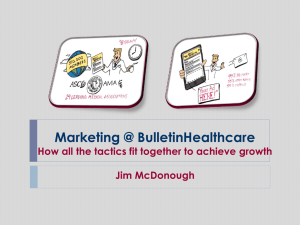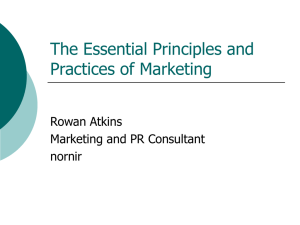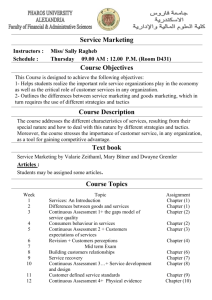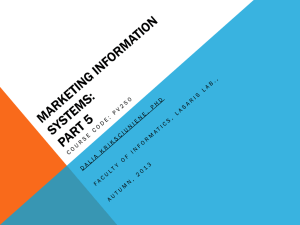Marketing Mix, Planning, Research & Implementation
advertisement
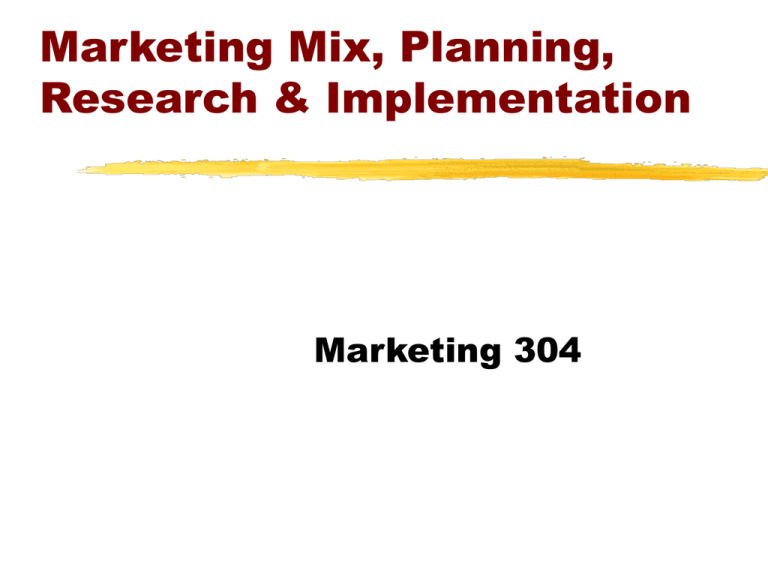
Marketing Mix, Planning, Research & Implementation Marketing 304 Where are the Marketing Jobs? Suppliers Manufacturer/Producer Distrs Direct Whslrs Whslrs Rtlrs Rtlrs Target Customer Consumers, Businesses, Institutions Local, Regional, National, Global A Contemporary Organization Vice President Production Marketing Comm. PRESIDENT Vice President Marketing. Sales •Advertising •Public Relations •Sales Promo •Special Events Vice President Finance Marketing Research Vice President Human Resources Product Planning Vice President Info Tech Physical Distribution Customer Service Fig. 21-1 The Marketing Mix Step One The Target Market -- Needs, Wants, Expectations Step Two The Positioning -- The Story Brand Image & Competitive Advantage Step Three “The 4 P’s” Product ---- Price ---- Place ---- Promotion The Marketing Mgm’t Process Detailed Marketing Mgm’t Process Scan -- Focus -- Act -- Scan -- Focus -- Act Conduct the situation analysis Develop marketing objectives Design marketing mix strategies and tactics Select target markets and measure market demand Determine positioning (brand image and competitive advantages) Decide “4P’s” (product, price, place and promotion) Implement marketing mix strategies and tactics Continuously evaluate . . . performance toward reaching objectives changes in the situation analysis Make necessary controls/changes to objectives, strategies, and/or tactics The Marketing Management Process Fig. 20-1 Scan -- Focus -- Act -- Scan -- Focus -- Act PLANNING Analyze situation Set objectives Select strategies and tactics IMPLEMENTATION Organize Staff Direct EVALUATION Compare performance with goals Marketing Information System (MkIS) Feedback, so management can adapt future plans and their implementation to the changing environment The Structure of a MkIS MkIS Requests for information MARKETING MANAGER • Collection • Analyses Regular and • Storage customized reports •Database DSS Fig. 7-1 Systems and Procedures for Data: • Retrieval and •Dissemination Planning begins with The Situation Analysis The Situation Analysis is research designed to: gather information regarding the environmental factors/forces influencing our marketing decisions, then analyzing that information, and forecasting the impact of whatever trends the analysis suggests. Those factors/forces may be: Macro or Micro External or Internal Uncontrollable or Semi-Controllable External Macroenvironmen tal Forces Figure 2-1 Economic condition s Demographics Competition COMPANY’S MARKETING PROGRAM Social and cultural forces Technology Political and legal forces External Microenvironments Forces Suppliers Figure 2-2 Marketing intermediaries COMPANY’S MARKETING PROGRAM Marketing intermediaries The market Internal Micro-Forces Financial resources COMPANY’S NONMARKETING RESOURCES Research and development Detailed Marketing Mgm’t Process Scan -- Focus -- Act -- Scan -- Focus -- Act Conduct the situation analysis Develop marketing objectives Design marketing mix strategies and tactics Select target markets and measure market demand Determine positioning (brand image and competitive advantages) Decide “4P’s” (product, price, place and promotion) Implement marketing mix strategies and tactics Continuously evaluate . . . performance toward reaching objectives changes in the situation analysis Make necessary controls/changes to objectives, strategies, and/or tactics Marketing Research Procedure Define the objective Conduct situation analysis Conduct informal investigation Further study needed ? No End project and report results Yes Plan and conduct formal investigation Analyze data and report results Conduct followup Fig. 7-3 Marketing Research Conduct an informal investigation --talk to people Conduct a formal investigation 1st -- Secondary research—data already gathered for some other purpose. 2nd -- Primary research—new data gathered specifically for the project at hand. Secondary data is found in: Libraries Government documents Trade and professional associations Private business firms--syndicated sources Internet, magazines, newspapers, radio and television stations University research organizations Company files and databases Primary data is gathered using: Quantitative Research -- Surveys, Questionnaires Projects findings from the sample to the populatio from which sample was taken. Qualitative -- Focus groups, depth studies Psychological interpretations of the participants’ responses. Experiments Laboratory Field -- Test markets Observation Personal Mechanical The Marketing Mgm’t Process Implementation Comprises Three Activities: Organizing the marketing effort Design the marketing organization Assign people/dpt’s. to tasks and roles Define the relationship between marketing and the other functional divisions of the firm Staffing the organization “People first, strategy second” Directing the execution of marketing plans Carry out strategies and tactics Direct the efforts of people Adjusting to changes (Continuous) Evaluation Market Evaluation On-going situation analysis updating Performance versus Objectives Evaluation On-going profit, sales, and market share analysis On-going marketing audit/cost analysis Is marketing research valuable? A survey of 100 consumer product brand managers revealed: Agree Disagree Research can predict marketplace performance. Research can uncover new customer needs. My company will change directions if market research indicates it is warranted. 59% 41% 41% 59% 60% 40% Rank in order of importance. The End Detailed Marketing Mgm’t Process Scan -- Focus -- Act -- Scan -- Focus -- Act Do Situation Analysis/Marketing Research Research company’s Marketing Environment Develop Marketing Objectives & Forecasts Set Marketing Mix Strategies & Tactics Select and measure target market(s) Positioning Brand Image Competitive Advantage(s) Product -- Price -- Place -- Promotion Implement Marketing Mix Strategies/Tactics Monitor Situation & Performance Marketing Information System (MkIS)
